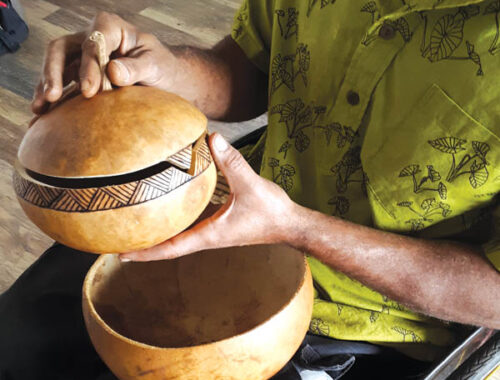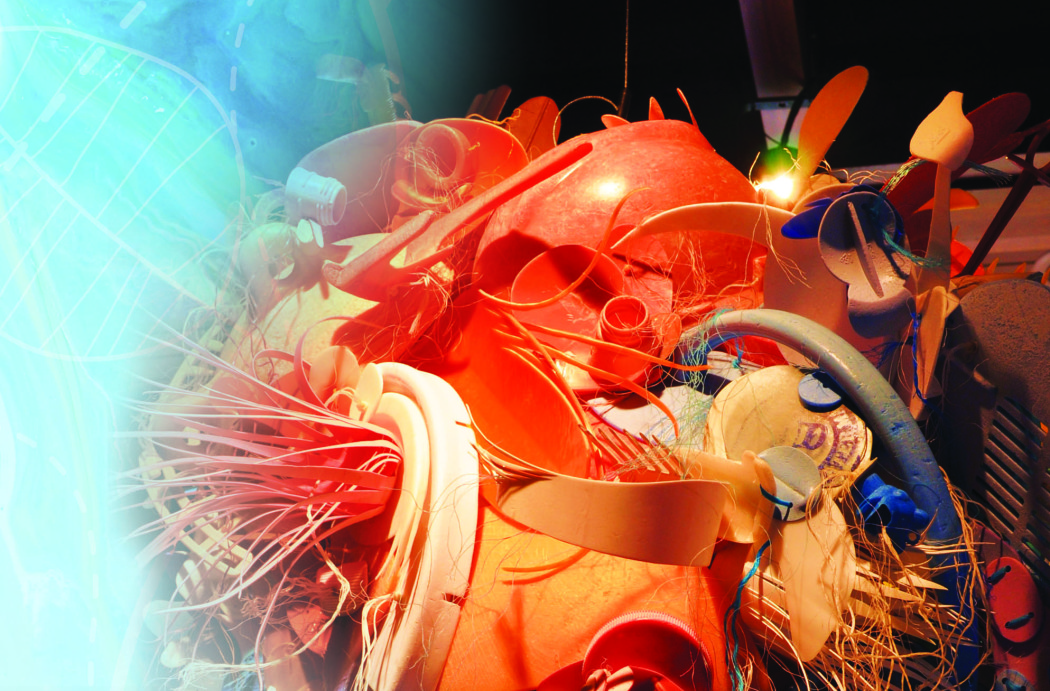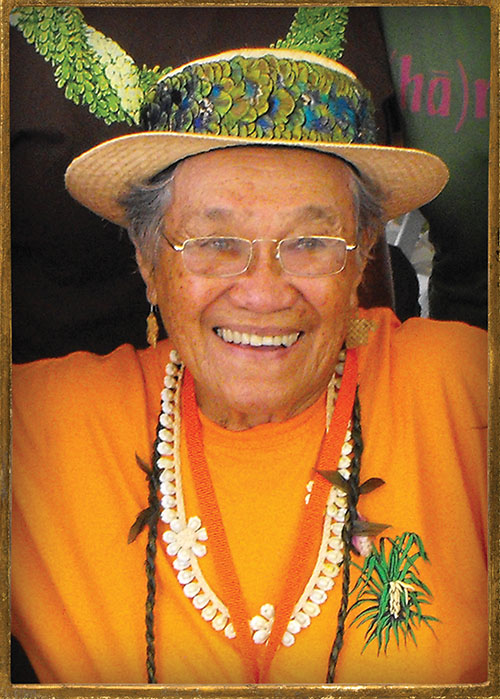
Aunty Elizabeth Malu‘ihi Lee: Lifelong Weaver Seeks to Pass on Hawaiian Tradition
 By Cynthia Sweeney
By Cynthia Sweeney
Growing up in Kohanaiki in the 1930s during the Great Depression, Aunty Elizabeth never imagined that one day people would come to Kailua-Kona from around the world to learn lauhala weaving from her.
“I never knew I would be this woman. But I got called to do this weaving,” she says. “I’m so thankful for the gift [of weaving] that I got.”
Aunty Elizabeth Malu‘ihi Lee was one of 14 children. At a young age she and her brother were hānai (adopted) into her Aunty’s family. Here, only Hawaiian was spoken and lauhala weaving was the number one priority.
By the age of six, she was ready to weave. Like her mother and brother, she began to weave lauhala into functional items like floor mats and mats used to sleep on as was custom in pre-colonized Hawai‘i. They also weaved baskets for picking coffee and hats for working in the fields. These items were used as currency and traded for material that went into making school dresses.
“We didn’t use money at that time,” Aunty Elizabeth remembers. “We traded at the store and got 10 or 20 cents a hat.”
Elizabeth proved to be adept at weaving. By age 10, she was making three or four hats a day, which were sold mostly to plantation workers. It was a challenge however, she admits, to sit night after night and weave, especially after a day of working the farm, raising taro, bananas, mango, and sugar cane that was planted by hand—a crop that was off-limits for them to eat. Elizabeth’s mother laid down the law and taught Elizabeth and her brother a keen sense of respect she lives by to this day.
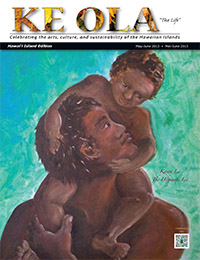
“We were taught to appreciate other people’s labor,” she explains. It was out of this notion of appreciation and respect for the person weaving floor mats that people removed their shoes before going into the house.”
Aunty Elizabeth also points out, “A hat is not an umbrella. We should respect it. You want to wear something nice and clean. That’s respect for our head and where we put our brain.”
Hōlualoa, where Aunty Elizabeth lives today, is known for it’s coffee farms and art galleries, and has been a hub for lauhala weaving for generations, largely due an abundance of the hala trees in Kona. She explains the time and effort that goes into weaving with lauhala. The leaves (lau means “leaf” in Hawaiian and hala is the pandanus tree) are collected dry, either from the ground or picked from the tree after they turn brown. The leaves are then sorted for matching color and hand cut with special tools for the desired width. The smaller the width, the more intricate the weave. To make the leaves pliable for weaving special care is given to cleaning the leaves. Aunty Elizabeth uses a variety of cleaning solutions to get rid of bugs, droppings, and anything else that might be clinging to the leaf. There are no guarantees. Occasionally, something slips through the process and eventually you notice that a bug is eating through a hat.
“When you see that, it hurts a lot,” Aunty says. “But [weaving] is something special. [We don’t know] what can happen and what cannot happen because there are natural things in the fiber.”

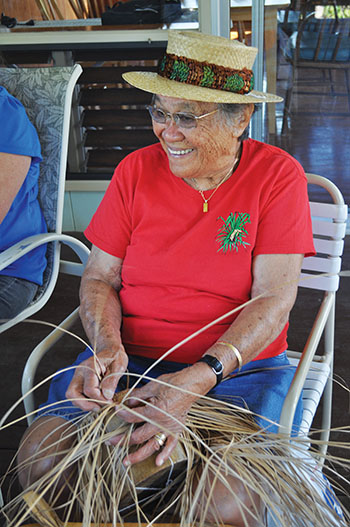
Each family of weavers developed their own patterns and techniques. As she refined her skill, Aunty Elizabeth started selling hats for more money, up to fifty cents, which was “big money.” Her hats began being worn by judges, attorneys, ministers, and priests. Poorer people did not wear them, she explained.
As the availability of cotton cloth, leather goods, and man-made fibers grew, however, the need for weaving declined, and some of the traditional weaving skills disappeared almost entirely.
Aunty Elizabeth used her skill and ingenuity to help bring back the lost art weaving with the makaloa leaf. Makaloa is a softer reed and more difficult to control than lauhala. When dried naturally, the reeds of the makaloa are red. When dried over a fire, they are bleached white. While Aunty says the bleached makaloa make beautiful hats for men, makaloa doesn’t last as long as the lauhala.
Aunty Elizabeth’s work has been commissioned by and is on display at the Bishop Museum, Hulihe‘e Palace, and at the Merrie Monarch Festival. In 1993 she was bestowed the honor of Living Treasure by the Office of Hawaiian affairs. After that recognition, she felt compelled to share her knowledge with anyone who wanted to learn. Despite opposition from those who felt it was not right to share Hawaiian secrets, she created the nonprofit Ka Ulu Lauhala O Kona in 1996 to perpetuate this traditional art from. The group holds an annual weaving conference in Kailua-Kona for anyone who wants to learn.
“Why can’t we teach this art?” she earnestly asks. “We teach Hawaiian language, Hawaiian culture, why not weaving? I want to share my knowledge. When God calls me home I can’t take it with me so I’ll leave it to those who want it.”
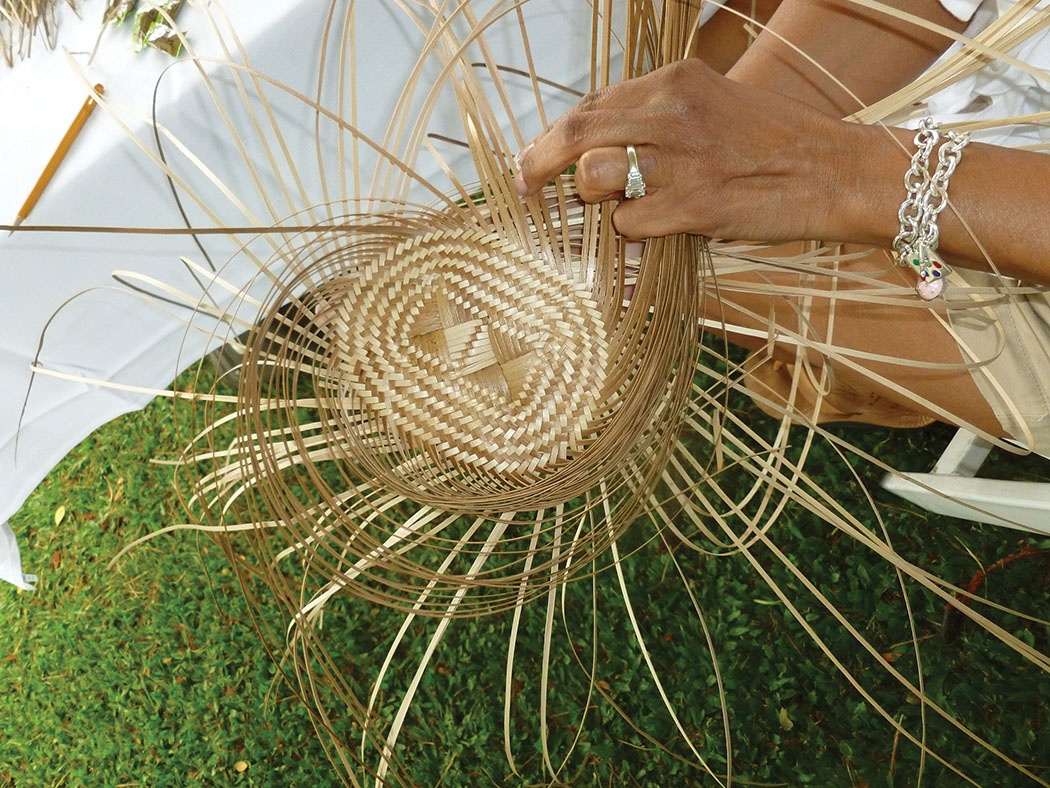
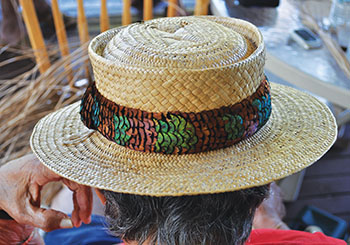
Aunty generously shares her gift over the four-day conference that draws people from all over the world: Japan, Canada, the mainland, even Greece. The days are filled with weaving classes for all levels, and concludes with a fashion show and lū‘au. Aunty Elizabeth is a hands-on instructor who easily shares her knowledge and experience.
“I try to encourage students to start simple with a wide weave—baskets, mats. If you try do a hat the first time, the student will get frustrated and the teacher will get frustrated right away. Patience is a key.”
These days, Aunty Elizabeth wears a fine, intricately woven hat with a deep blue and green peacock feather lei pāpale (hatband) wrapped around it. When asked how much the hat is worth, she removes it and sets it on the table. She points out the important features of this hat: its rare color, the fine, tightly woven rows of the brim, the geometric pattern on the crown, and the bands of felt inside to protect the hat from perspiration. Asked when she made this had she smiles and points out a small label inside where 1968 is handwritten. Aunty’s hats now start at about $150. This particular hat, she said, would go for about $1,600, however $2,500 may be closer to its true value.
At 84, Aunty Elizabeth is thankful for friends who help her get around and thankful for students who are interested in keeping her art alive. She still takes time to talk story at Kamehameha schools, speaking in Hawaiian, sharing her gift of weaving, and reflecting on her humble beginnings.
Aunty Elizabeth can’t imagine slowing down.
“My body says ‘slow down’ but my brains says ‘go’,” she chuckles. “I try to stop because of my health, but I can’t get out of weaving.”
Aunty Elizabeth’s artwork can be found at the Merrie Monarch Festival, craft shows, and the upcoming conference.
This year the Ka Ulu Lauhala O Kona conference will be held May 15-18 at the Courtyard King Kamehameha’s Kona Beach Hotel. Aunty emphasizes it is open to anyone, and there will be scholarships available to pay for classes. ❖
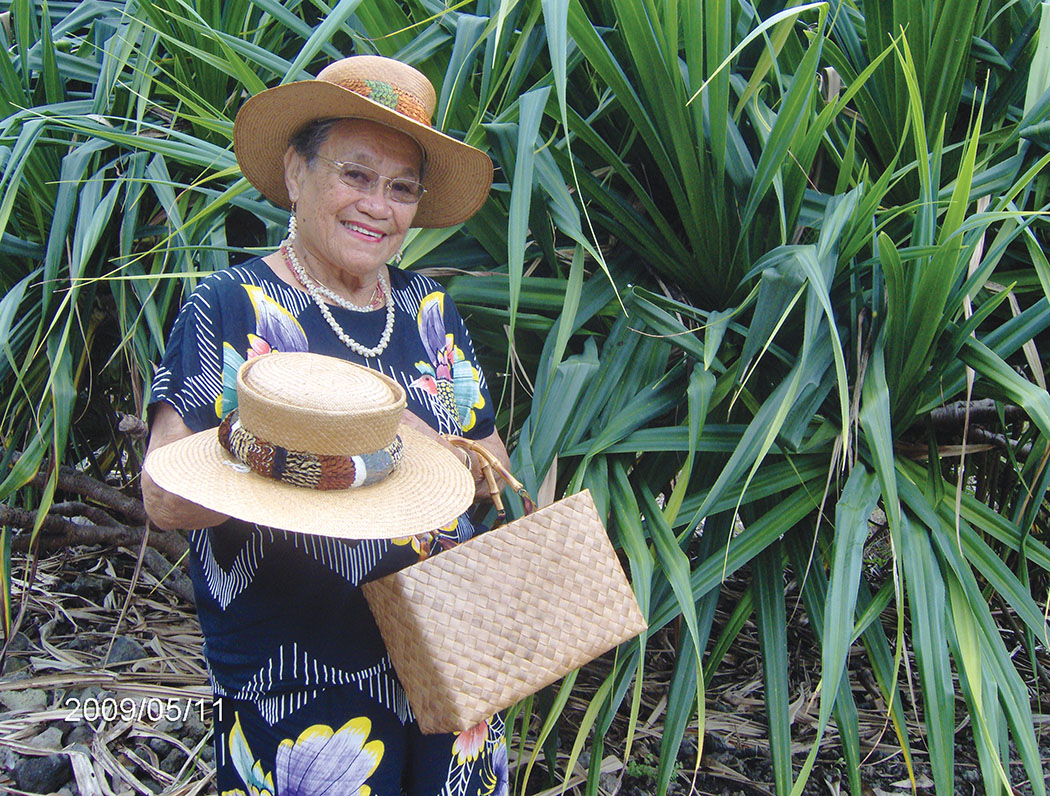
Conference information: Barbara Kossow, 808.938.0806
Contact Aunty Elizabeth: 808.938.4765
Photos by Gayle ‘Kaleilehua’ Greco, Renée Robinson
Contact writer Cynthia Sweeney: sweeneywrites@yahoo.com

